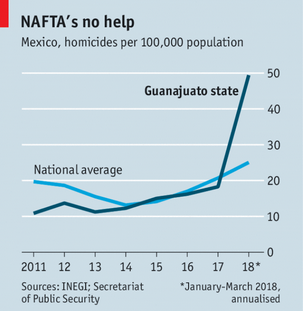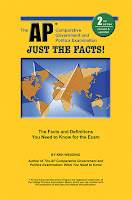Effects of violence on government and politics - 2
How are the demands on government and the state in Mexico similar to and different from those in Nigeria?
Mexico’s murder rate heads for a new record
Teaching Comparative blog entries are indexed. Use the search box to look for country names or concept labels attached to each entry.
What You Need to Know 7th edition is ready to help.
Order the book HERE
Amazon's customers gave this book a 4-star rating.
Mexico’s murder rate heads for a new record
IN APASEO EL GRANDE, a town in the central Mexican state of Guanajuato, the bodies are stacking up… In the first three months of this year the municipality of 85,000 people had 43 murders, up from 20 in all of 2016. That is about the same as London, a city 100 times larger and currently panicking about its high murder rate…
The town and the state it belongs to are suffering from a double blow. One is a national crime wave, during which the murder rate broke through its previous record of 2011. That peak came after the then president, Felipe Calderón, deployed the army to fight drug gangs. His tactic of capturing or killing kingpins caused the gangs to split into warring factions and to enter new lines of business. The current president, Enrique Peña Nieto, who took office in 2012, promised to halve the murder rate. Instead, after an initial decline it rose sharply…
The rise in violence is among the main issues in the general election scheduled for July 1st. Nearly half of Mexicans say crime is the main problem in their area…
Guanajuato’s prosperity, once thought to deter crime, now seems to be attracting it. The state’s south is part of an industrial corridor that stretches from Aguascalientes to Querétaro. Factories in the region produce cars and other goods for tariff-free export to the United States and Canada under the North American Free-Trade Agreement. A quarter of Guanajuato’s workforce is employed in manufacturing…
Mexico’s location, between South America’s coca fields and the United States’ drugs market, makes it vulnerable. But the persistence of violence is the fault of a weak state, and especially of inadequate policing, prosecution and courts. Widespread corruption greatly worsens the problem…
Police investigate just a quarter of murders. In part that is because there are too few police… Police and officials are underpaid, and thus tempted to work for criminals rather than against them. They are also poorly trained. In many states, more than 90% of arrests are of suspects caught red-handed, which shows that police have little capacity to investigate crimes more than an hour or two after they happen…
Another problem is co-ordination. Mexico has municipal, state and federal police forces, plus the army, which Presidents Calderón and Peña pressed into service against criminals. In many states municipal and state-level police do not use the same radio frequencies and therefore cannot communicate…
Areas where violence has surged recently are especially unprepared to deal with it. Guanajuato has one forensics specialist per 10,000 crimes; the national average is 18. Police numbers there are less than a quarter of the interior ministry’s standard…
Mr Peña’s efforts to improve policing have largely failed. He proposed creating a 40,000-strong force that would establish control over areas infested by crime. But the government cut back its funding and the army refused to let civilians command it…
A more promising initiative is a reform of the criminal-justice system, which is taking place gradually across the country. This shifts courtroom procedures away from document-based decision-making by a judge [inquisitorial] to argumentative methods used in the United States [adversarial]…
Teaching Comparative blog entries are indexed. Use the search box to look for country names or concept labels attached to each entry.
What You Need to Know 7th edition is ready to help.
Order the book HERE
Amazon's customers gave this book a 4-star rating.





Comments
Post a Comment